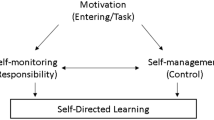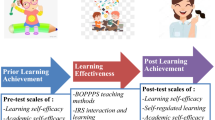Abstract
Self-directed learning requires students to take the initiative to learn and control their learning process. Scholars have provided evidence for the positive effect of self-directed learning on academic achievement, and they emphasize the importance of self-direction for lifelong learning. Yet, a limited study has been conducted in K-12 education. Additionally, most research investigated students’ perceived competence in self-directed learning, but little has studied students’ behavior in self-direction practice. To fill the gap, we propose a technology-based approach to facilitate self-direction practice in the K-12 context. A GOAL system was developed to support several self-direction tasks: conduct Collection-Reflection step with self-data and Analysis-Evaluation step with accumulated self-data from two learning aspects of learning outcome and learning effort. We explored their behavioral patterns based on the interaction logs generated by 122 EFL high school students while performing those tasks across one semester. Four clusters were found to have different behavioral patterns in those tasks. Further analysis suggested a positive correlation between self-direction behavior and academic achievement. And we found that students who not only collected and reflected on self-data but also analyzed and evaluated their learning status got higher academic achievement than those who only collected and reflected on self-data or rarely engaged in any tasks. This study contributes to a technology-based approach that helps to track students’ self-direction behavior. This study extends self-direction research to the K-12 context and provides evidence for the positive impact of self-directed learning on academic achievement from a new perspective.






Similar content being viewed by others
Data availability
Not available.
Code availability
Not available.
References
Adams, N. E. (2015). Bloom’s taxonomy of cognitive learning objectives. Journal of the Medical Library Association: JMLA, 103(3), 152.
Bentley, T. (2012). Learning beyond the classroom: Education for a changing world. Routledge.
Bidokht, M. H., & Assareh, A. (2011). Life-long learners through problem based and self directed learning. Procedia Computer Science, 3, 1446–1453. https://doi.org/10.1016/j.procs.2011.01.028
Boyer, S. L., Edmondson, D. R., Artis, A. B., & Fleming, D. (2014). Self directed learning: A tool for lifelong learning. Journal of Marketing Education, 36(1), 20–32. https://doi.org/10.1177/0273475313494010
Brandt, W. C. (2020). Measuring student success skills: A review of the literature on self-directed learning 21st century success skills. National Center for the Improvement of Educational Assessment.
Brockett, R. G., & Hiemstra, R. (1991). Self-direction in adult learning: Perspectives on theory, research, and practice. Routledge.
Candy, P. C. (1991). Self-direction for lifelong learning a comprehensive guide to theory and practice. ERIC.
Changhao, L., Toyokawa, Y., Nakanishi, T., Majumdar, R., & Ogata, H. (2021). Supporting peer evaluation in a data-driven group learning environment. In International conference on collaboration technologies and social computing (pp. 93-100).
Chen, N.-S., Yin, C., Isaias, P., & Psotka, J. (2020). Educational big data: Extracting meaning from data for smart education (Vol. 28) (No. 2). Taylor and Francis.
Cheng, S.-F., Kuo, C.-L., Lin, K.-C., & Lee-Hsieh, J. (2010). Development and preliminary testing of a self-rating instrument to measure self-directed learning ability of nursing students. International Journal of Nursing Studies, 47(9), 1152–1158.
Chou, P.-N., & Chen, W.-F. (2008). Exploratory study of the relationship between self-directed learning and academic performance in a web-based learning environment. Online Journal of Distance Learning Administration, 11(1), 15–26.
Fisher, M., King, J., & Tague, G. (2001). Development of a self-directed learning readiness scale for nursing education. Nurse Education Today, 21(7), 516–525.
Garrison, D. R. (1992). Critical thinking and self-directed learning in adult education: An analysis of responsibility and control issues. Adult Education Quarterly, 42(3), 136–148.
Garrison, D. R. (1997). Self-directed learning: Toward a comprehensive model. Adult Education Quarterly, 48(1), 18–33.
Greveson, G., & Spencer, J. (2005). Self-directed learning-the importance of concepts and contexts (Vol. 39) (No. 4). Wiley Online Library.
Hara, K. (1995). Quantitative and qualitative research approaches in education. Education, 115(3), 351–356.
Hiemstra, R. (1994). Self-directed learning. In W. J. Rothwell & K. J. Sensenig (Eds.), The sourcebook for self-directed learning (pp. 9–20). Amherst, MA: HRD Press.
Huang, T.-C., Shu, Y., Chang, S.-H., Huang, Y.-Z., Lee, S.-L., Huang, Y.- M., & Liu, C.-H. (2014). Developing a self-regulated oriented online programming teaching and learning system. In 2014 ieee international conference on teaching, assessment and learning for engineering (tale) (pp. 115-120).
Khalid, M., Bashir, S., & Amin, H. (2020). Relationship between selfdirected learning (sdl) and academic achievement of university students: A case of online distance learning and traditional universities. Bulletin of Education and Research, 42(2), 131–148.
Khiat, H. (2017). Academic performance and the practice of self-directed learning: The adult student perspective. Journal of further and Higher Education, 41(1), 44–59.
Knowles, M. S. (1975). Self-directed learning: A guide for learners and teachers. In J. Crook (Ed.), A validation study of a self-directed learning readiness scale. Journal of Nursing Education, 24, 274–279.
Knowles, M. S. (1990). Fostering competence in self-directed learning. Learning to learn across the life span, 1, 123–136.
Lasfeto, D. (2020). The relationship between self-directed learning and students social interaction in online learning environment. Journal of e-Learning and Knowledge Society, 16(2), 34–41.
Li, H., Flanagan, B., Konomi, S., & Ogata, H. (2018). Measuring behaviors and identifying indicators of self-regulation in computer-assisted language learning courses. Research and Practice in Technology Enhanced Learning, 13(1), 1–12.
Li, J., Majumdar, R., & Ogata, H. (2021). Mining mathematics learning strategies of high and low performing students using log data. In 2021 international conference on advanced learning technologies (icalt) (pp. 229–230).
Loyens, S. M., Magda, J., & Rikers, R. M. (2008). Self-directed learning in problem-based learning and its relationships with self-regulated learning. Educational Psychology Review, 20(4), 411–427.
Majumdar, R., Yang, Y. Y., Li, H., Akçapinar, G., Flanagan, B., & Ogata, H. (2018, November). Goal: Supporting learner’s development of selfdirection skills using health and learning data. ICCE 2018–26th International Conference on Computers in Education, Main Conference Proceedings, 406-415.
Mejia, C., Florian, B., Vatrapu, R., Bull, S., Gomez, S., & Fabregat, R. (2016). A novel web-based approach for visualization and inspection of reading difficulties on university students. IEEE Transactions on Learning Technologies, 10(1), 53.67.
Mocker, D. W. (1983). Lifelong learning: Formal, nonformal, informal, and self-directed. Adult Education, 33(4), 260. https://doi.org/10.1177/0001848183033004009
P21-Framework. (2009). A framework for 21st century learning. Retrieved July 5 July, 2022, from http://www.p21.org/our-work/p21-framework.
Palys, T. (2008). Purposive sampling. The Sage Encyclopedia of Qualitative Research Methods, 2, 697–8.
Patterson, C., Crooks, D., & Lunyk-Child, O. (2002). A new perspective on competencies for self-directed learning. Journal of Nursing Education, 41(1), 2531. https://doi.org/10.3928/0148-4834-20020101-06
Pérez-Álvarez, R., Maldonado-Mahauad, J., & Pérez-Sanagust, Ln. M. (2018). Design of a tool to support self-regulated learning strategies in moocs. Journal of Universal Computer Science, 24(8), 1090–1109.
Rashid, T., & Asghar, H. M. (2016). Technology use, self-directed learning, student engagement and academic performance: Examining the interrelations. Computers in Human Behavior, 63(604), 612.
Rosenthal, R. (1991). Effect sizes: Pearson’s correlation, its display via the besd, and alternative indices. American Psychologist, 46(10), 1086–1087. https://doi.org/10.1037/0003-066X.46.10.1086
Shinoda, S., & Yoneyama, T. (2018). Vintage english grammar. Iizuna Shoten.
Stauffer, C., & Grimson, W. E. L. (2000). Learning patterns of activity using real-time tracking. IEEE Transactions on Pattern Analysis and Machine Intelligence, 22(8), 747–757.
Stockdale, S. L., & Brockett, R. G. (2011). Development of the pro-sdls: A measure of self-direction in learning based on the personal responsibility orientation model. Adult Education Quarterly, 61(2), 161–180.
Takeoka Hironobu, C. I. (2018). Leap essential vocabulary. Suken Shuppan.
Tekkol, I. A., & Demirel, M. (2018). An investigation of self-directed learning skills of undergraduate students. Frontiers in Psychology, 9, 2324.
Van Merriënboer, J. J. G. (1997). Training complex cognitive skills: A fourcomponent instructional design model for technical training. Englewood Cliffs: Educational Technology Publications.
Wang, D., & Han, H. (2021). Applying learning analytics dashboards based on process-oriented feedback to improve students’ learning effectiveness. Journal of Computer Assisted Learning, 37(2), 487–499.
Wilcox, S. (1996). Fostering self-directed learning in the university setting. Studies in Higher Education, 21(2), 165–176.
Williamson, S. N. (2007). Development of a self-rating scale of self-directed learning. Nurse Researcher, 14(2), 66–83.
Wu, J. (2012). Cluster analysis and k-means clustering: An introduction. Advances in k-means clustering (pp. 1–16). Springer.
Wurdinger, S. D., McDermott, J. C., Harell, K., & Smith, H. (2019). Empowering our students for the future: Encouraging self-direction and life-long learning. Rowman and Littlefield.
Yamada, M., Oi, M., & Konomi, S. I. (2017). Are learning logs related to procrastination? From the viewpoint of self-regulated learning. In International conference on cognition and exploratory learning in digital age (CELDA 2017) (pp. 3–10).
Yang, Y., Majumdar, R., Li, H., Flanagan, B., & Ogata, H. (2022). Design of a learning dashboard to enhance reading outcomes and self-directed learning behaviors in out-of-class extensive reading. Interactive Learning Environments. https://doi.org/10.1080/10494820.2022.2101126
Yin, C., Yamada, M., Oi, M., Shimada, A., Okubo, F., Kojima, K., & Ogata, H. (2019). Exploring the relationships between reading behavior patterns and learning outcomes based on log data from e-books: A human factor approach. International Journal of Human-Computer Interaction, 35(4–5), 313–322.
Zhao, F., Hwang, G.-J., & Yin, C. (2021). A result confirmation-based learning behavior analysis framework for exploring the hidden reasons behind patterns and strategies. Educational Technology and Society, 24(1), 138–151.
Funding
This work was supported by JSPS [Grant No. 22H03902, 20K20131], NEDO Special Innovation Program on AI and Big Data [grant number JPNP18013].
Author information
Authors and Affiliations
Contributions
YY drafted the initial manuscript and data analysis. HL and RM provided insights. RM designed the architecture of the system. YY and HL implemented the software system and supporting algorithms, and performed the experiments. HO, RM secured funding to support this project. HO provided supervision of the research. All authors read and approved the final manuscript.
Corresponding author
Ethics declarations
Conflict of interest
The authors declare that they have no conflict of interest.
Ethical approval
The study was approved by the school committee of the particular public school in Kyoto city.
Consent to participate
All the participants and their parents were explained about the GOAL system and the data that is collected for the research. The participants had consent for the study.
Consent for publication
All the participants had given the consent to use the data collected in GOAL for research and academic reporting.
Additional information
Publisher's Note
Springer Nature remains neutral with regard to jurisdictional claims in published maps and institutional affiliations.
Rights and permissions
Springer Nature or its licensor (e.g. a society or other partner) holds exclusive rights to this article under a publishing agreement with the author(s) or other rightsholder(s); author self-archiving of the accepted manuscript version of this article is solely governed by the terms of such publishing agreement and applicable law.
About this article
Cite this article
Yang, Y., Li, H., Majumdar, R. et al. GOAL system for online self-direction practice: exploring students’ behavioral patterns and the impact on academic achievement in the high school EFL context. J. Comput. Educ. 11, 595–614 (2024). https://doi.org/10.1007/s40692-023-00272-0
Received:
Revised:
Accepted:
Published:
Issue Date:
DOI: https://doi.org/10.1007/s40692-023-00272-0




